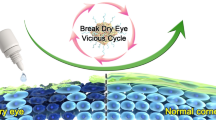Abstract
Introduction
TobraDex® ophthalmic suspension (tobramycin 0.3%, dexamethasone 0.1%; Alcon Laboratories Inc, Fort Worth, Tex) is frequently used for inflammatory ocular conditions where a risk of bacterial ocular infection exists. A new formulation, TobraDex® ST ophthalmic suspension (tobramycin 0.3%, dexamethasone 0.05%, Alcon), utilises a novel suspension technology to reduce viscosity and help prevent settling in the container.
Methods
A rabbit model that closely mimics the human eye and a clinical study with cataract patients was used to compare the pharmacokinetics and tissue permeability of TobraDex ST and TobraDex. An in-vitro model was used to assess the bactericidal activity using the rabbit tear concentrations of tobramycin 10 minutes after a single topical dose.
Results
Concentrations of both tobramycin and dexamethasone were greater in the tear film and ocular tissues of rabbits treated with TobraDex ST. There was an 8.3-fold increase in tobramycin concentration in the rabbit tear film 10 minutes after dosing with TobraDex ST compared with TobraDex. Concentrations of tobramycin and dexamethasone in ocular tissues from rabbits exposed to TobraDex ST were up to 12.5-fold greater relative to TobraDex. The in-vitro bactericidal activity (>99.9% kill, 3-log reduction) of TobraDex ST toward tobramycin-resistant and methicillin-resistant Staphylococcus aureus occurred in 90 minutes. TobraDex ST killed Streptococcus pneumoniae 3-log in 5 minutes. TobraDex had no activity toward tobramycin-resistant, methicillin-resistant S. aureus and required approximately 120 minutes for 3-log reduction of S. pneumoniae. In humans, the mean ratio of dexamethasone levels in the aqueous humour at 1 hour was 1.17 in favour of TobraDex ST.
Conclusion
TobraDex ST demonstrated improved suspension formulation characteristics, enhanced pharmacokinetic distribution and improved bactericidal characteristics, and may provide a useful alternative as compared to TobraDex.
Similar content being viewed by others
References
Kim JY, Ali R, Cremers SL, Henderson BA. Perioperative prophylaxis for postcataract extraction endophthalmitis. Int Ophthalmol Clin. 2007;47:1–14.
Wirbelauer C. Management of the red eye for the primary care physician. Am J Med. 2006;119:302–306.
Kowalski RP, Yates KA, Romanowski EG, Karenchak LM, Mah FS, Gordon YJ. An ophthalmologist’s guide to understanding antibiotic susceptibility and minimum inhibitory concentration data. Ophthalmology. 2005;112:1987.
Lichtenstein SJ, Wagner RS, Jamison T, Bell B, Stroman DW. Speed of bacterial kill with a fluoroquinolone compared with nonfluoroquinolones: clinical implications and a review of kinetics of kill studies. Adv Ther. 2007;24:1098–1112.
Owen GR, Brooks AC, James O, Robertson SM. A novel in vivo rabbit model that mimics human dosing to determine the distribution of antibiotics in ocular tissues. J Ocul Pharmacol Ther. 2007;23:335–342.
Levine JM, Noecker RJ, Lane LC, Herrygers L, Nix D, Snyder RW. Comparative penetration of moxifloxacin and gatifloxacin in rabbit aqueous humor after topical dosing. J Cataract Refract Surg. 2004;30:2177–2182.
Robertson SM, Curtis MA, Schlech BA, et al. Ocular pharmacokinetics of moxifloxacin after topical treatment of animals and humans. Surv Ophthalmol. 2005;50(suppl 1):S32–S45.
Wagner RS, Abelson MB, Shapiro A, Torkildsen G. Evaluation of moxifloxacin, ciprofloxacin, gatifloxacin, ofloxacin, and levofloxacin concentrations in human conjunctival tissue. Arch Ophthalmol. 2005;123:1282–1283.
Rhee SS, Mah FS. Comparison of tobramycin 0.3%/dexamethasone 0.1% and tobramycin 0.3%/loteprednol 0.% in the management of blepharo-keratoconjunctivitis. Adv Ther. 2007;24:60–67.
Notivol R, Amin D, Whitling A, Wells D, Kennedy M, Cockrum PC. Prophylactic effectiveness of tobramycin-dexamethasone eye drops compared with tobramycin/ vehicle eye drops in controlling post-surgical inflammation in cataract patients: prospective, randomised, double-masked, two-arm, parallel-group, placebo-controlled, multicentre study. Clin Drug Invest. 2004;24:523–533.
Notivol R, Bertin D, Amin D, Whitling A, Kennedy M, Cockrum PC. Comparison of topical tobramycin-dexamethasone with dexamethasone-neomycin-polymyxin and neomycin-polymyxin-gramicidin for control of inflammation after cataract surgery: results of a multicenter, prospective, three-arm, randomized, double-masked, controlled, parallel-group study. Clin Ther. 2004;26:1274–1285.
Tobramycin. In: US Pharmacopoeia (USP31, NF 26). Rockville, MD: United States Pharmacopeial Convention; 2008;3:3418–3419.
Author information
Authors and Affiliations
Corresponding author
Rights and permissions
About this article
Cite this article
Scoper, S.V., Kabat, A.G., Owen, G.R. et al. Ocular distribution, bactericidal activity and settling characteristics of TobraDex® ST ophthalmic suspension compared with TobraDex® ophthalmic suspension. Adv Therapy 25, 77–88 (2008). https://doi.org/10.1007/s12325-008-0019-9
Published:
Issue Date:
DOI: https://doi.org/10.1007/s12325-008-0019-9




